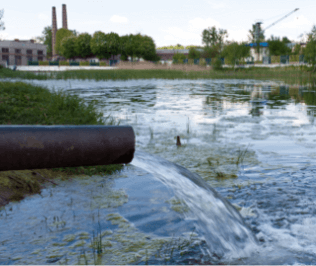-
PRODUCTS
- Lab Instruments
- Lab Meters and Probes
- Chemistries, Reagents, and Standards
-
Online Analyzers
Ammonium Analysers Ammonia Monochloramine Chlorine Analyzers
- CL17sc
- CL10sc Amperometric
- 9184 sc Amperometric
- เครื่องวิเคราะห์คลอรีนด้วยการวัดสี Ultra Low Range CL17sc
EZ Series Analysers- Iron
- Aluminium
- Manganese
- Phosphate
- Chloride
- Cyanide
- Fluoride
- Sulphate
- Sulphide
- Arsenic
- Chromium
- Copper
- Nickel
- Zinc
- Ammonium
- Total Nitrogen
- Total Phosphorus
- Phenol
- Volatile Fatty Acids
- Alkalinity
- ATP
- Hardness
- Toxicity
- Sample Preconditioning
- Boron
- Colour
- Nitrate
- Nitrite
- Silica
- Hydrogen Peroxide
- EZ Series Reagents
- EZ Series Accessories
- EZ sc Series Inorganics
- EZ sc Series Metals
- EZ sc Series Nutrients
-
Online Sensors and Controllers
Ammonium Sensors Conductivity Sensors
- 3400 Analogue Contacting
- 3400 Digital Contacting
- 3700 Analogue Inductive
- 3700 Digital Inductive
- 9525 DCCP System
- Industrial UV
- Flow and Collections
- Automated Lab Systems
- Multiparameter Online Panels
- Test Kits & Strips
- Microbiology
- Lab Equipment and Supply
- Samplers
- Electrochemistry
- PARAMETERS
- APPLICATIONS
- INDUSTRIALS
- E-SHOP
- Service
- BRANDS
Hach Thailand
เลือกประเทศหรือภูมิภาคของคุณ:
Europe
Americas
Asia - Australasia
- Australia
- Mainland China
- India
- Indonesia
- Japan
- Malaysia
- New Zealand
- Philippines
- Singapore
- South Korea
- Thailand (Thai)
- Taiwan
- Vietnam
Middle East - Africa
Chemistries ONLINE SHOP: +6693 769 9254
Wastewater Treatment for the Food Industry
Produce the best quality foods with the best quality water.
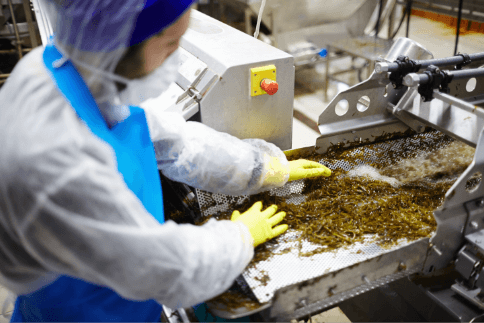
As a food business, your wastewater treatment process varies depending on your unique goals.
If you’re a food provider that works with poultry, meat, dairy, or oil, your wastewater requires pre-treatment because of the high-strength wastes your facility generates.
On the other hand, maybe your facility conducts simple treatment before sending wastewater to a municipal treatment plant. In such cases it’s likely that your municipal partner compels your facility to meet certain requirements.
Explore Products Now
Treatment Overview
Regardless of your facility’s unique needs, if your business fails to meet requirements, your plant can face fines from the wastewater plant, the State, or even the EPA. These limits usually depend on your specific effluent permit along with the characteristics of your industrial facility’s waste stream.
Explore the following wastewater parameters for guidance and expertise.
pH
pH measurement
Continuous monitoring of pH is key to alerting you to necessary process adjustments well in advance of a violation. And pH monitoring at various stages within your wastewater treatment process is critical for optimizing chemical usage, preventing corrosion and controlling costs.
pH
pH measurement
Results of effective management include:
- Separation of dissolved waste from water during treatment
- Optimization of biological processes, especially nitrification
- Monitoring plant upsets from industrial discharges
- Minimizing costs of chemical additives like disinfectants
BOD
Biochemical Oxygen Demand
BOD provides a relative measure of "food" available to your biological treatment process steps. It also indicates the degree of stabilization of your wastewater. And it gives you an estimate of the effect of the effluent on your receiving water body.
BOD
Biochemical Oxygen Demand
Results of effective management include the ability to use BOD data for plant loading and design considerations.
COD
Chemical Oxygen Demand
COD is the sum parameter that provides the most reliable and timely information about the oxygen-depleting effects of organic pollutants in wastewater. COD also supplies an estimate of the effect of your plant’s effluent on the receiving body.
COD
Chemical Oxygen Demand
Results of effective management include the ability to use COD as a surrogate for BOD, correlating it to BOD on a plant-by-plant basis if influent characteristics are constant.
F
Flow
Your effective wastewater treatment includes measurement of standard in-pipe flow rates for NPDES permit requirements.
F
Flow
Results of effective management include the ability to accurately and reliably establish concentrations or the total presence of key analytes throughout the production process.
FOG
Fats, Oils and Grease
Industrial food facilities commonly use TSS measurements for wastewater discharge reporting. You can reduce the potential of putting excessive solids into your wastewater stream through on-line TSS monitoring and regular sampling.
FOG
Fats, Oils and Grease
Results of effective management include optimum use of water treatment resources, such as energy and chemical addititves
TSS
Total Suspended Solids
Industrial food facilities commonly use TSS measurements for wastewater discharge reporting. You can reduce the potential of putting excessive solids into your wastewater stream through on-line TSS monitoring and regular sampling.
TSS
Total Suspended Solids
Results of effective management include optimization of:
- Mixed liquor suspended solids concentration
- Return activated sludge and waste activated sludge concentration
- Influent suspended solids concentration
- Effluent suspended solids concentration and percent removal
Industrial Food Wastewater Applications
Nutrient Control
Properly treating your water can help you confidently know that your effluent stream meets permitted levels. Correct dosing is part of proper nutrient control—a process crucial to minimizing nutrient discharge and optimizing your plant’s performance. With appropriate dosing, you’ll avoid wasting resources on overtreatment. In short, plant operators are hit with costs two ways – paying too much for dosing chemicals while still being fined for excess phosphorus.
Nitrogen Removal
What if you face unfavorable nutrient ratios and high concentrations of individual substances? These challenges can reduce the degradation efficiency of your biological wastewater treatment process. It’s important to detect issues early through continuous monitoring of critical parameters and take rapid corrective action when necessary.
Phosphorus Removal
It’s integral that you control levels of phosphorus—a chemical element that promotes organic growth—in your food plant’s wastewater.
If you fail to control phosphorus accurately, your water quality will be negatively impacted and this can lead to large fines.
The widespread practice of manually testing effluent only at set time intervals often leads to overdosing or underdosing with chemical control:
- Overdosing occurs when control continues at the same rate even when phosphorus levels are low.
- Underdosing happens when phosphorus levels spike in the interval between tests. This sends excess phosphorus into the stream before control measures can be adjusted.
Aeration
Activated sludge is one of the most widely used wastewater treatment processes available today, and dissolved oxygen is a key parameter for ensuring that the microorganisms vital to a successful process remain viable.
How does it work? Oxygen is introduced into wastewater along with microorganisms to develop a biological floc, which reduces the organic content of your wastewater.
Dissolved Air Flotation (DAF)
Often in food processing plants, a DAF is used to reduce loadings and clarify wastewater. Tiny air bubbles are released into the tank causing small particulates to float to the top where they are skimmed off.
To remove larger suspended solids, coagulant is dosed into the feed water—this helps to speed up clumping and settling. Typically, chemical is dosed to the DAF based on flow rate, but dosing based on flow ignores the solids concentration. This leads to under- and over-dosing which could waste chemicals, increase your hauling costs, and result in fines.
You can stop over treating and reduce your total costs by using real-time data to dose coagulant based on solids concentrations.
Sludge Treatment
Sludge treatment applications depend on your sludge quality and characteristics. Different types of sludges will affect sludge treatment options and, ultimately, disposal. This complexity often means that sludge management is a costly operation in your wastewater treatment.
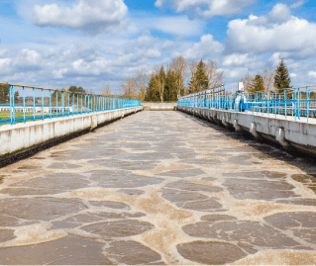
Organics Monitoring
You know that all food sources have an organic component, and that monitoring organics in water and drain lines helps your production facility quickly and accurately measure the carbon content in your water streams. This lets you:
- Maximize production yield
- Mitigate compliance risks
- Protect capital equipment
What if your wastewater has high organic loads? In such cases your facility should use chemical treatment and physical processing to reduce load levels for either re-use or discharge into the environment.
Your efficient management of organics should involve BOD for reporting purposes. Yet since the test takes five days, you can use surrogates like COD, Total Organic Carbons (TOC), and Spectral Absorption Coefficient (SAC). These offer quicker test results and early detection of upsets or spills for reduced operational and maintenance costs.
Surrogates
COD and TOC, relatively simple lab procedures, reduce testing time to two hours.
Total Organic Carbon (TOC) is a measure of the carbon content of dissolved and undissolved organic matter present in a liquid sample. Here’s how it occurs in wastewater:
- Organic carbon and hydrocarbon materials appear due to spills, accidents, cleaning operations, leaks and component failures in the industry.
- TOC is increased in water when high organic compounds are discharged to water bodies.
Monitoring TOC on-line is recommended to provide results every seven minutes and monitor continuously.
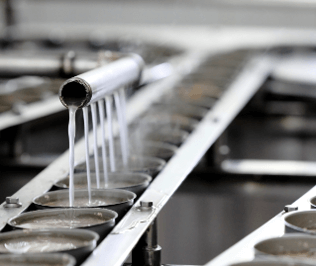
Sampling Methods
Your analysis is only as good as your sample
Even the most exacting laboratory analysis can't compensate for improper sample collection, or for a sample that’s altered because of inappropriate transport or storage.
When determining your water quality and whether you’re complying with regulations, only correct sampling procedures will deliver accurate lab results. Not only can precise sampling improve your process and data, but it can lower costs, too. Pull samples at times relative to the rate of flow and as most relevant to your specific process.
Consider using both flow and automatic sampling in your wastewater process:
- Use flow proportional sampling for more representative data
- Use automatic sampling to collect unbiased samples. Such samples:
- Characterize wastewater and its impact on receiving bodies
- Comply with discharge requirements
- Provide process control by verifying lab samples
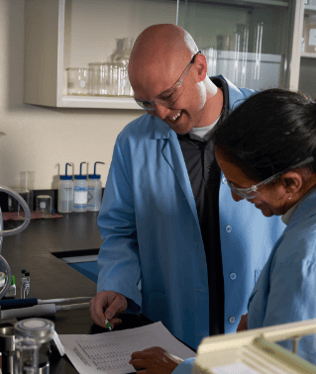
Wastewater Treatment Regulations
Wastewater treatment regulations and permit limits vary from region to region and country to country.
Target limits generally are established by the acting authority. Wastewater plants then measure and report to demonstrate compliance with established limits. In this way, governing bodies and plants alike monitor and maintain important parameters that indicate water quality and environmental and health standards. As a result they ensure the continued health and safety of the populations being served.
Wastewater Technologies
As a growing field of expertise within the wastewater treatment industry, Water Intelligence Systems use digital technologies, advanced sensors, controllers, and algorithms to allow plant operators to increase efficiencies leading to overall cost savings in running the plant.
Claros™, the Water Intelligence System from Hach, integrates all plant data sources, including system data, device data, and manually-collected data, driving decisions to maximize efficiency and cost savings.
With Water Intelligence Systems, you can track and verify data on flow rate, water composition, dissolved-oxygen, nutrient levels and other factors more easily. Advantages include responsive treatment options, automation capabilities, data visualization and report generation.
Data-driven insights into water quality, flow rate, and other factors allow you to reduce overtreatment (chemicals as well as aeration blower run time) while knowing your plant will remain within compliance limits.
As regulations become stricter and plants need to find cost-savings, Water Intelligence Systems like Claros will become more important and widely adopted. And with Hach’s growing suite of Claros-Enabled sensors, controllers, devices, process management systems, and lab equipment, you can configure a system that fits the unique requirements of your plant.
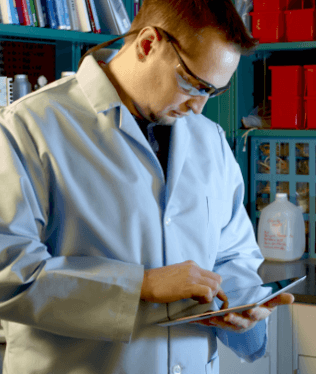
Resources for Food Industry Wastewater Applications
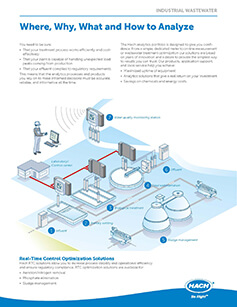
Industrial Wastewater: Where, Why, What and How to Analyze
How to ensure that your treatment process works efficiently and cost effectively, that your plant is capable of handling unexpected load peaks coming from production, and that your effluent complies to regulatory requirements.
READ MORE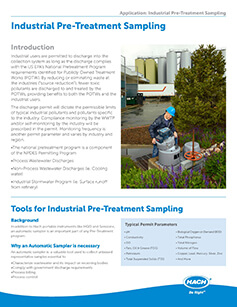
Industrial Pre-Treatment Sampling
Industrial users are permitted to discharge into the collection system as long as the discharge complies with the US EPA’s National Pretreatment Program requirements identified for Publicly Owned Treatment Works (POTW)…
READ MORE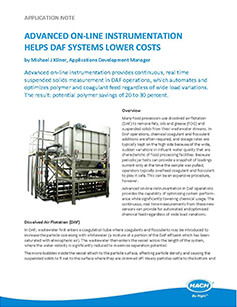
Advanced On-Line Instrumentation Helps DAF Systems Lower Cost
Advanced on-line instrumentation provides continuous, real time suspended solids measurement in DAF operations, which automates and optimizes polymer and coagulant feed regardless of wide load variations.
READ MORE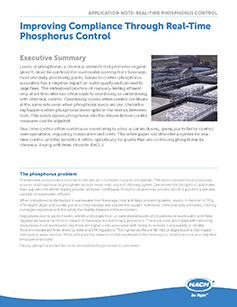
Improving Compliance Through Real-Time Phosphorus Control
Levels of phosphorus must be controlled in wastewater coming from beverage, food and dairy processing plants. Failure to control phosphorus accurately has a negative impact on water quality and can lead to large fines.
READ MORE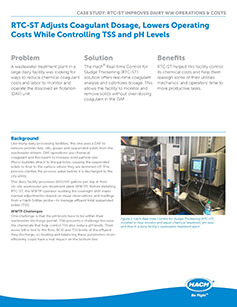
RTC-ST Improves Dairy Wastewater Operations & Costs
A wastewater treatment plant in a large dairy facility was looking for ways to reduce chemical coagulant costs and labor to monitor and operate the dissolved air flotation (DAF) unit...
READ MORE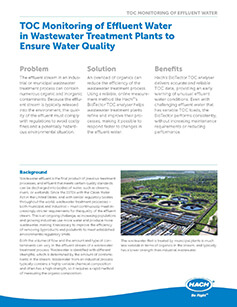
TOC Monitoring of Effluent Water in Wastewater Treatment Plants
The effluent stream in an industrial or municipal wastewater treatment process can contain numerous organic and inorganic contaminants. Because the effluent stream is typically released into the environment, the quality of the effluent must...
READ MORE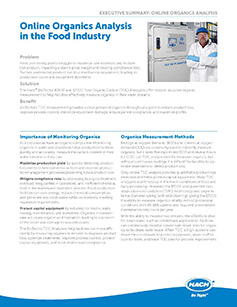
Online Organics Analysis in Food Industry
Food processing plants struggle to maximize raw materials and reclaim lost product, impacting a plant’s gross margin and creating compliance risks. Further, undetected product can foul mechanical equipment, leading to production issues and equipment downtime.
READ MORE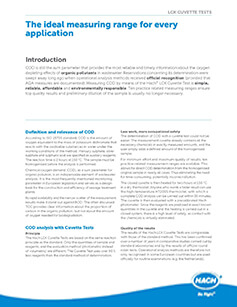
The Ideal Measuring Range for Every Application
COD is still the sum parameter that provides the most reliable and timely information about the oxygen depleting effects of organic pollutants in wastewater. Reservations concerning its determination were swept away long ago when operational analysis methods received official recognition.
READ MORE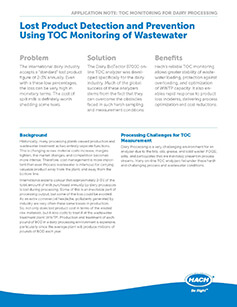
Lost Product Detection and Prevention Using TOC Monitoring
The international dairy industry accepts a “standard” lost product figure of 2-3% annually. Even with these low percentages, the loss can be very high in monetary terms. The cost of spilt milk is definitely worth shedding some tears.
READ MORE
What should you measure?
As a food industry professional responsible for managing your wastewater treatment process, you often work with the parameters and processes listed below. Take a deeper dive into how each one impacts your overall wastewater management and explore guides to optimize your approach.
BOD
What's behind Biochemical Oxygen Demand (BOD)?
Analyzing BOD reveals a lot about your wastewater: how much “food” is available to your biological treatment steps; how stable your wastewater is; and the impact of effluent on your receiving water body.
BOD measurements actually detect the amount of oxygen (in m/L or ppm) that bacteria take from water as they oxidize organic matter that has been introduced from natural sources and pollution. This organic matter, including carbohydrates (e.g. cellulose, starch and sugars), proteins, petroleum hydrocarbons and other materials, may be dissolved or suspended as particulate matter, as in solids in sewage.
Why Control BOD?
A primary focus of wastewater treatment plants is to reduce the BOD in the effluent discharged. Quite importantly, measurement of BOD is required as part of your environmental discharge permit and is an important parameter for evaluating the effectiveness of your wastewater treatment operation.
Explore resources related to BOD
> Video: Hach Solution for Accurate and Reliable BOD Results
COD/TOC
Why Test for Chemical Oxygen Demand (COD)?
A COD test represents the amount of chemically digestible organics in your wastewater. COD measures all biochemically digestible organics as well as all organics that can be digested by heat and sulfuric acid. It is used in the same applications as BOD.
COD testing is superior to BOD in that you can complete the analysis within a few hours whereas BOD requires five days. The major drawback of COD testing is the presence of hazardous chemicals and toxic waste disposal.
Why Test for Total Organic Carbon (TOC)?
- TOC is a key indicator of water contamination.
- TOC is an industry standard indicator for process control and equipment protection.
- TOC levels are an early detection indication of process "health" to enable optimum water purification performance of RO or demineralizer elements.
- An elevated TOC level indicates leaks in the manufacturing process.
A best practice in determining TOC is to use analyzers at various stages of the treatment process.
Explore resources related to COD
Dissolved Oxygen
Why Monitor Dissolved Oxygen (DO)?
Your facility’s aeration and activated sludge processes require a steady supply of oxygen to function effectively.
Insufficient oxygen results in process inefficiency, producing foul-smelling intermediate products and incomplete reactions. Too much oxygen results in excessive energy consumption.
Because aeration and activated sludge processes constitute up to 70% of a wastewater plant’s energy costs, precise monitoring and control of oxygen allows for effective and efficient functionality.
Explore resources related to COD
Nitrogen
What's Nitrogen's Role in Wastewater treatment?
Nitrogen enters wastewater treatment plants mainly as ammonia and is typically removed biologically. Using aeration, the nitrification stage utilizes aerobic bacteria to turn ammonia into nitrite and then nitrate. Nitrogen removal happens in the denitrification stage as bacteria consume the oxygen from nitrate turning it into nitrogen gas that escapes into the atmosphere.
Why Monitor Nitrate and Ammonia?
Simply put, by monitoring nitrate you can save money on your energy costs. Because most wastewater treatment plants play it safe by running their blowers full speed 24 hours a day, 7 days a week, aeration can be 70% of a plant’s budget. Knowing your nitrate and ammonia levels with seasonal or daily fluctuations is critical to save you money by knowing when to turn off the blowers.
Explore resources related to Nitrogen
pH
What is pH?
pH measures the hydrogen ion activity in wastewater, which has a direct influence on how treatable the water is. Controlling pH can enable more efficient utilization of other biological or chemical treatment resources, in addition to saving time and money.
What's a good pH value?
The pH of wastewater leaving manufacturing plants and wastewater purification plants must be within a specific pH window as set forth by local, state or federal regulatory agencies. While this value is typically between 5 and 9 pH, it can vary from area to area.
Explore resources related to pH
Phosphorus
How to Manage Phosphorus Removal
Phosphorus must be converted from a soluble form to an insoluble form and removed through precipitation. Chemical phosphorus removal uses iron or aluminum compounds to combine with and precipitate out phosphate.
Over treating water with these chemicals, while an effective method for ensuring permit compliance, will result in wasted chemical spend and increased sludge production for your facility. But you can easily control phosphorous in real time by dosing based on the volume present as opposed to a single set point.
Turbidity and TSS
Why do Turbidity and TSS Matter?
As measurements which are commonly used for wastewater discharge reporting, turbidity and TSS also control dissolved air flotation systems and dewatering equipment.
When applied to polymer feed systems, the additional control often results in significant polymer savings.
How to Monitor Turbidity and TSS
On-line monitoring and regular sampling protocols reduce the potential of putting excessive solids into the wastewater stream and help prevent permit violations and associated fines.
Explore Resources Related to Turbidity, TSS, and DAF
> Case Study: RTC-ST Improves Dairy WW Operations & Costs [PDF]
Which measurement options are right for you?
No two industrial wastewater treatment facilities are exactly alike. Food producers often have specific needs. Could a portable solution improve your process? Would greater coordination between process and lab measurements enhance your product? Or perhaps your operation would benefit from more efficient maintenance, rapid testing or more accurate data logging and transfer. No matter your requirements, Hach has the information, technology and support to help.
Process Wastewater Testing: Key Factors
Sometimes it’s essential to monitor wastewater continuously. Around-the-clock monitoring helps you confirm your facility’s compliance, more quickly discover process upsets, and collect real-time optimization data. Continuous monitoring gives you the flexibility to adjust treatment operations in real time, all while reducing costs for disinfection and nutrient dosing. It’s for these reasons that Hach recommends using process analyzers alongside laboratory measurements for verification and calibration.
Properly maintained and calibrated process analyzers also can help you reduce user error. Common errors include those made from grab sampling, improper sampling, and during sample preparation.
Hach offers an expanding suite of Claros-enabled digital sensors and controllers as part of a water intelligence system that allows for better 24-7 wastewater monitoring.
Find the right testing solution
Lab Wastewater Testing: Key Factors
Lab meters and analyzers are the most versatile instruments for periodic wastewater analysis, calibrating your process analyzers, and monitoring compliance. From routine laboratory tasks to demanding photometric, titration, and electrochemical applications, you can use meters and analyzers to limit sample waste and to reduce the time you spend on measurements.
Advanced benchtop lab meters help eliminate guesswork and feature sophisticated yet simple user interfaces. Select meters connect with smart sensors that automatically recognize your testing parameter, calibration history, and method settings to minimize errors and setup time.
Find the right testing solution
Portable Wastewater Testing: Key Factors
Hach portable solutions for wastewater are simple, accurate, rugged and designed to withstand years of use in the field. Solutions include interchangeable probes which use optical technology to provide fast, accurate measurements while dramatically reducing maintenance costs. Many portable options let you store, log, and transfer data via USB connections. Use portable instruments to easily carry out spot checks anywhere in the plant or field, all without the need for a laptop.
Find the right testing solution
Boost Your Lab Game with TNTplus with Truecal
See how Truecal can help you more confidently measure many wastewater parameters like COD, Total N, Ammonia, and more.
Learn More About Truecal
Assure safety and compliance in food production with accurate measurement tools
For more than 80 years, Hach has delivered innovative solutions for precise wastewater management. Our instruments for the food industry are no exception, offering the accuracy and simplicity you depend on.
BioTector B7000i
Organic contamination in water can cause significant issues requiring water managers to act quickly.
Shop Now
BioTector B3500c
Organic contamination in water can cause significant issues requiring water managers to act quickly.
Shop Now
AS950
The AS950 Portable Sampler’s lightweight design, low power requirements, and easy mobility make it ideal for field applications.
Shop Now
HQ440D
Designed for water quality experts, the advanced Hach HQD laboratory meters take the guesswork out of measurements.
Shop Now
EZ Series Analyzers
The Hach® EZ Series covers a unique range of parameters on a single analyzer platform.
Shop Now
Chemistries & Reagents
Understanding our customers applications has allowed us to formulate reagents that ensure exceptional performance and deliver trusted results.
Shop Now
DR3900
The DR3900 spectrophotometer provides the simplest way to perform tests for water analysis.
Shop NowDifferential pH Sensors
The inline process pH sensors feature exceptional performance due to the Differential Electrode Measurement Technique.
Shop Now
TSSsc Sensors
Hach's TSS sc are digital special probes for determining turbidity and suspended solids in aqueous, and also aggressive, media, in accordance with DIN EN ISO.
Shop Now
LDO sc
Hach’s next generation LDO® (Luminescent Dissolved Oxygen) Probe requires no calibration for the entire 2 year life of the sensor cap, which means it is ready to start measuring your DO (Dissolved Oxygen) right out of the box.
Shop Now




